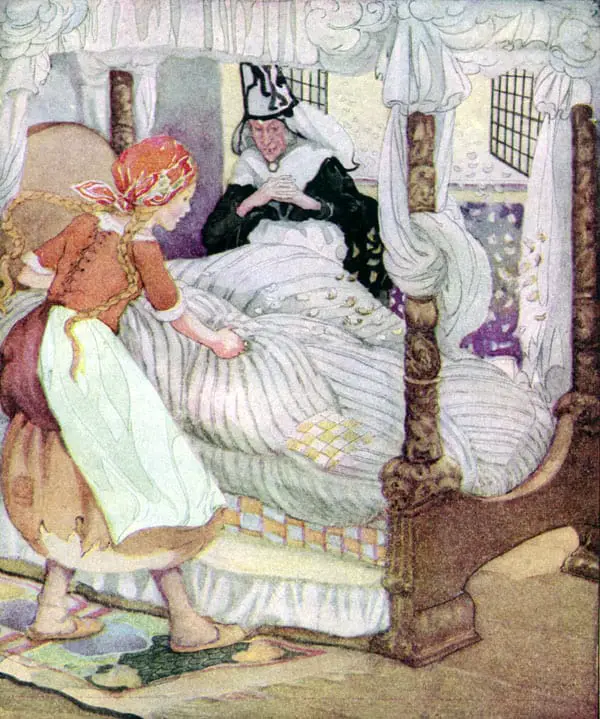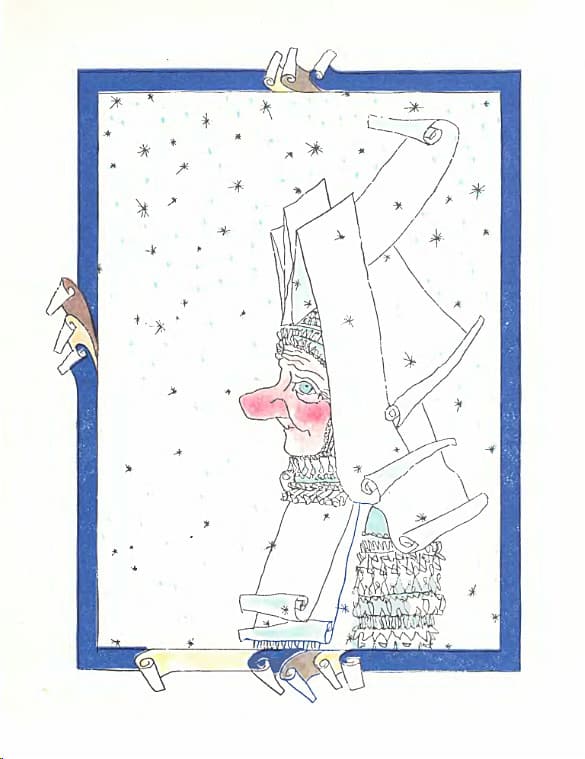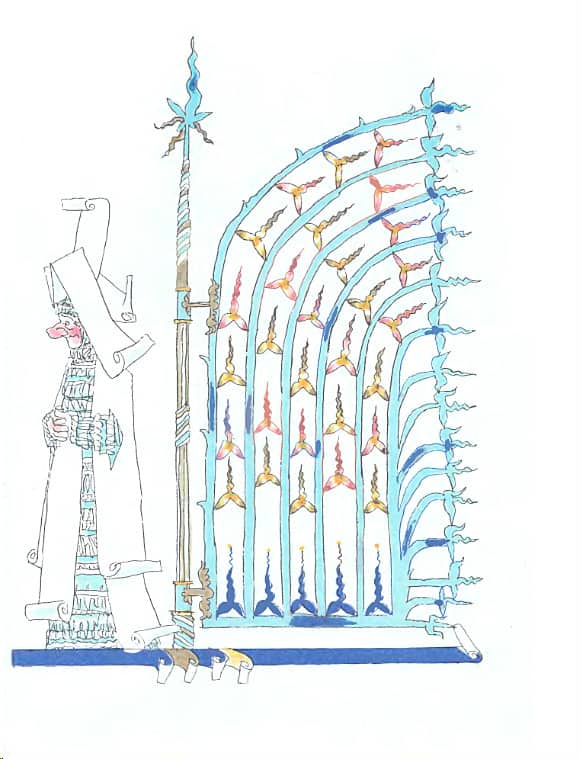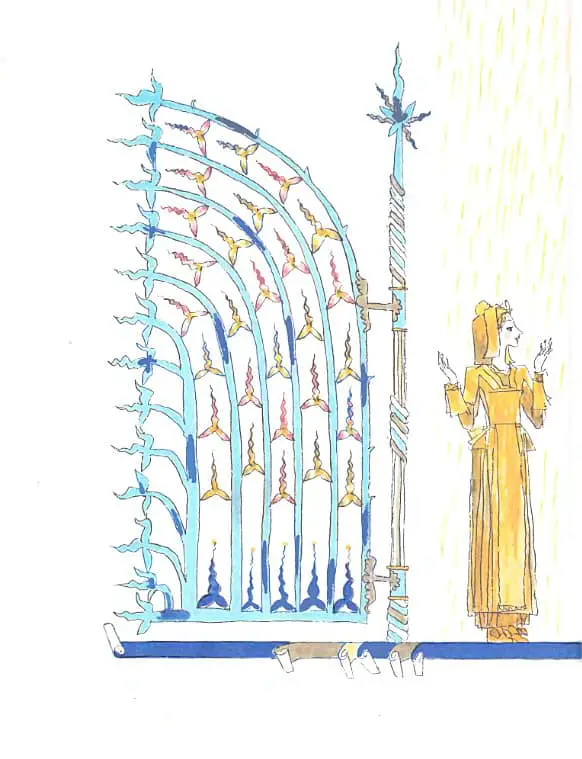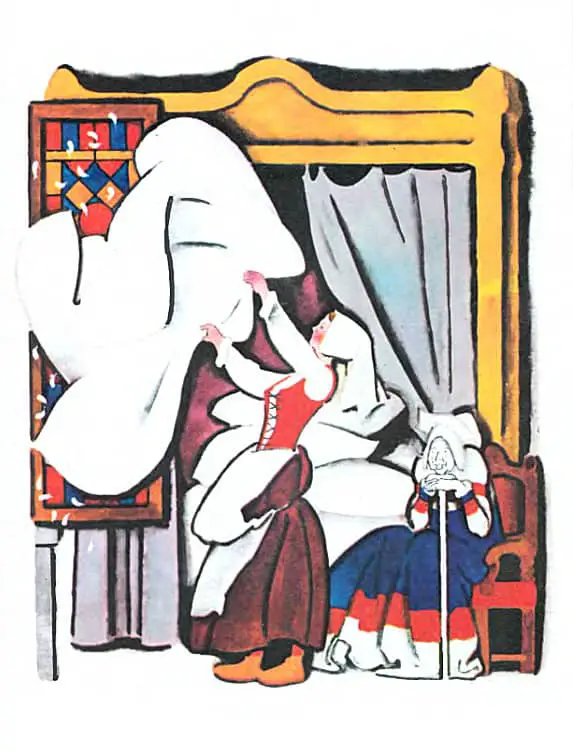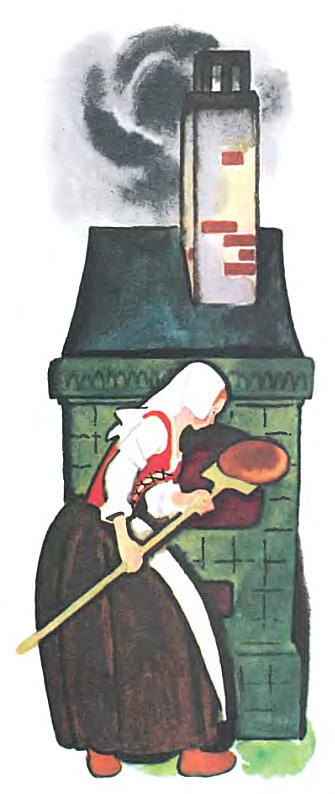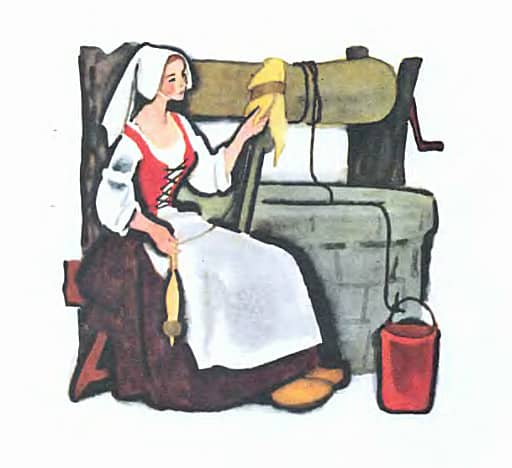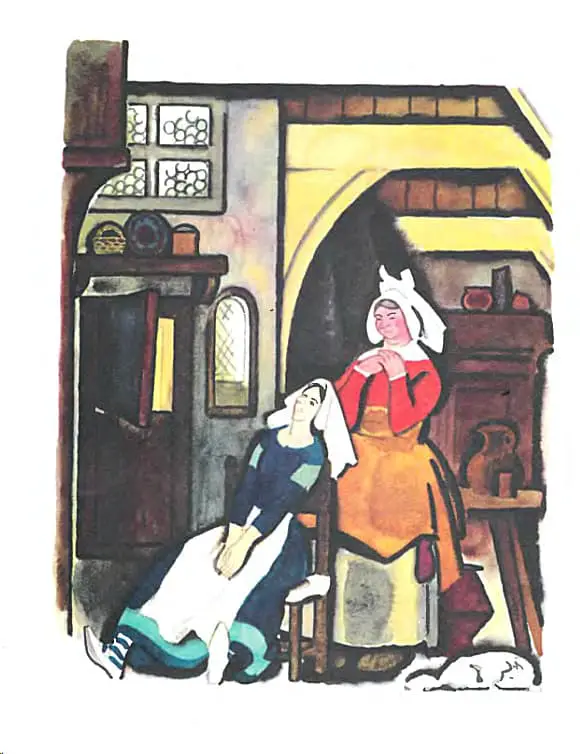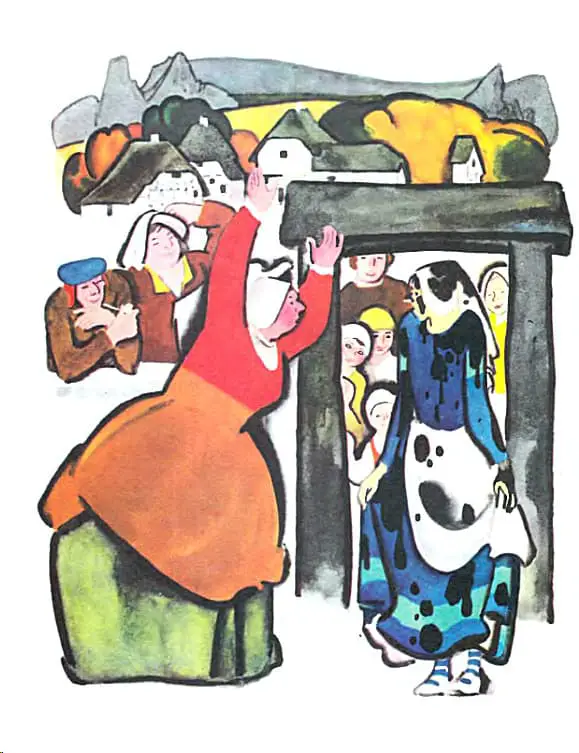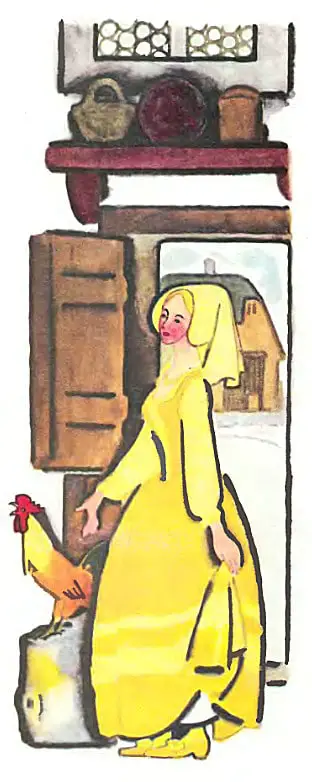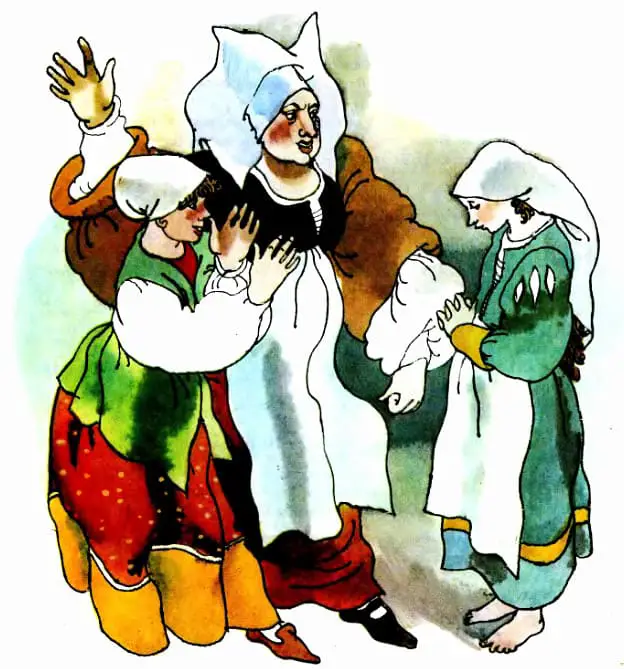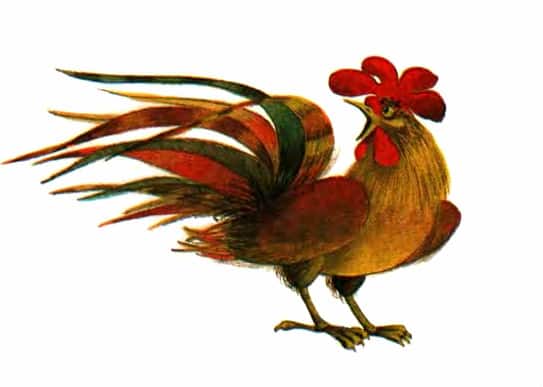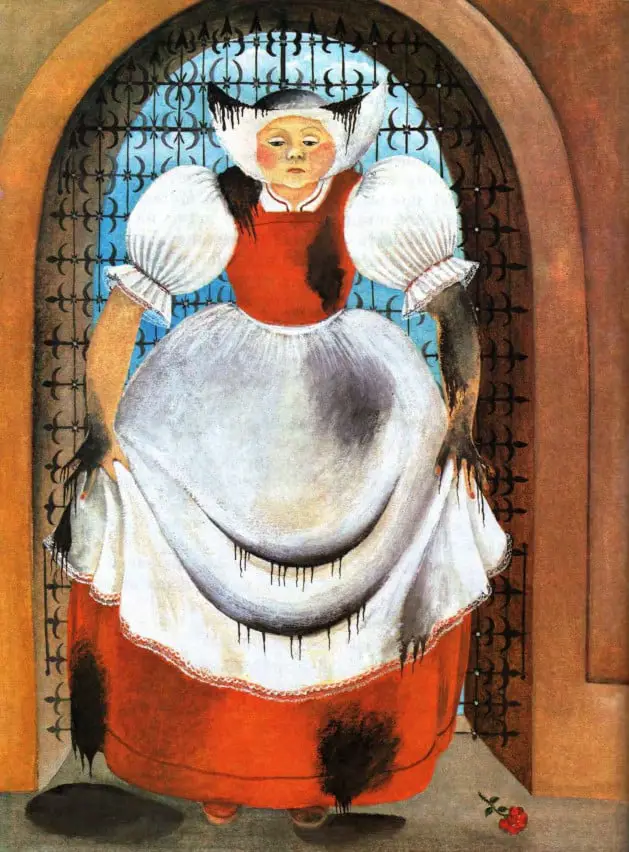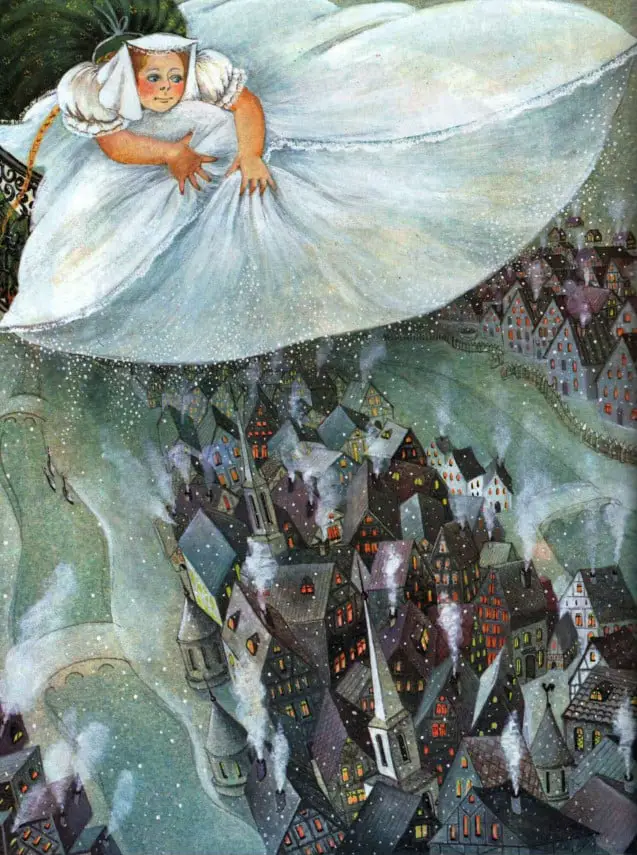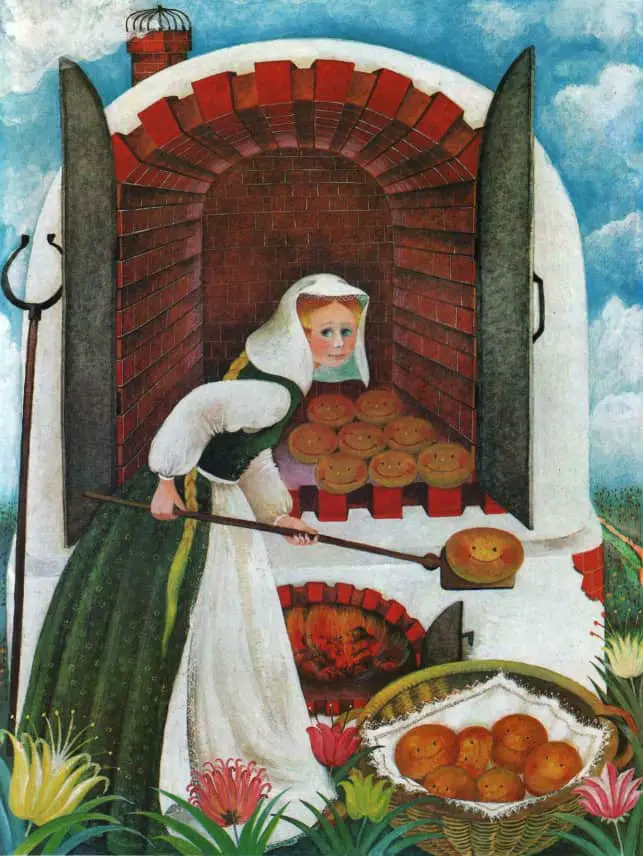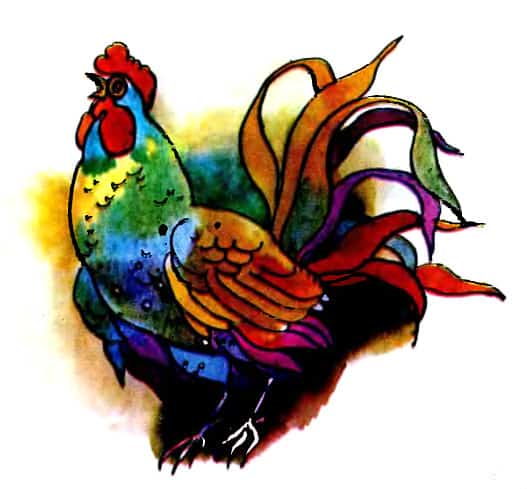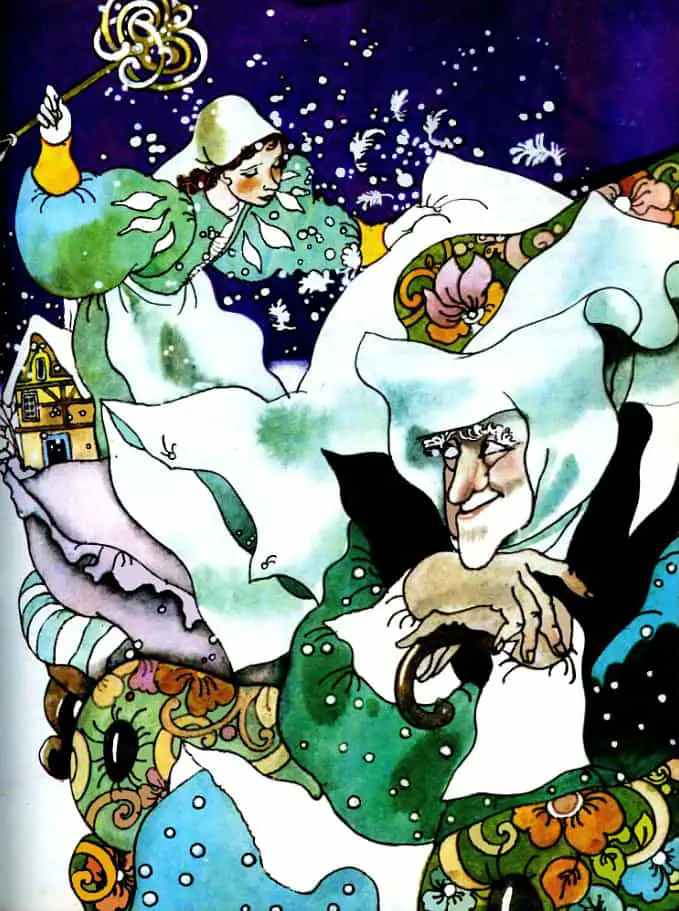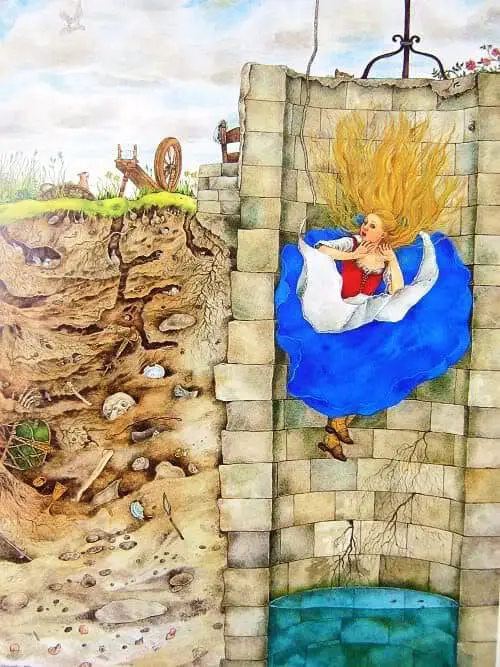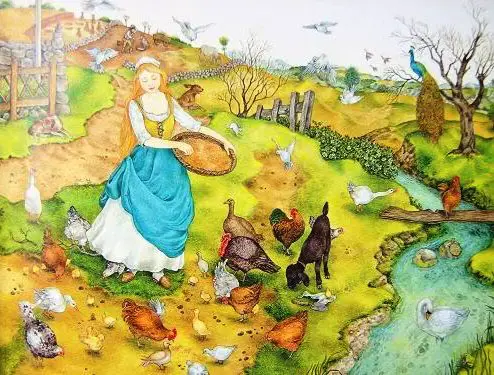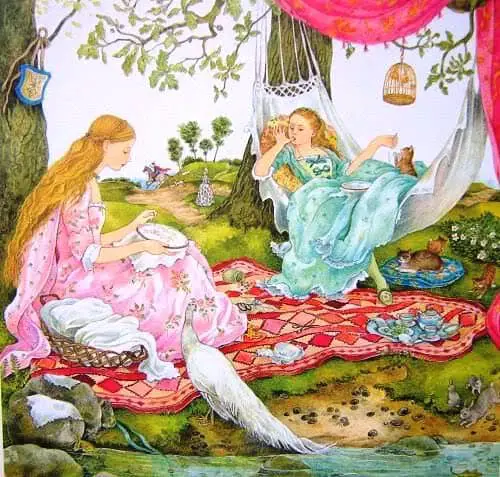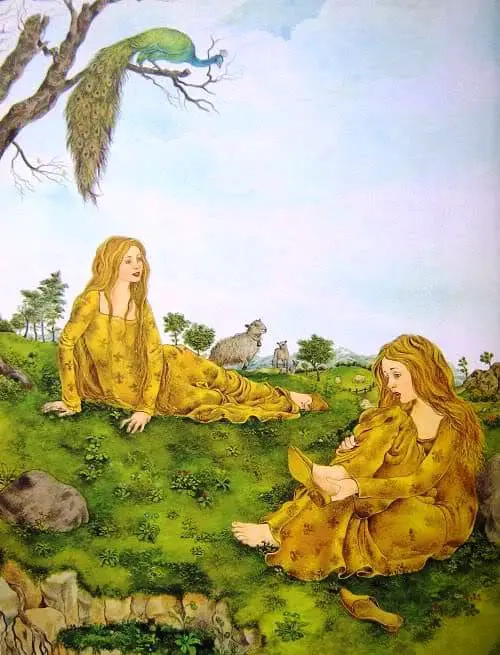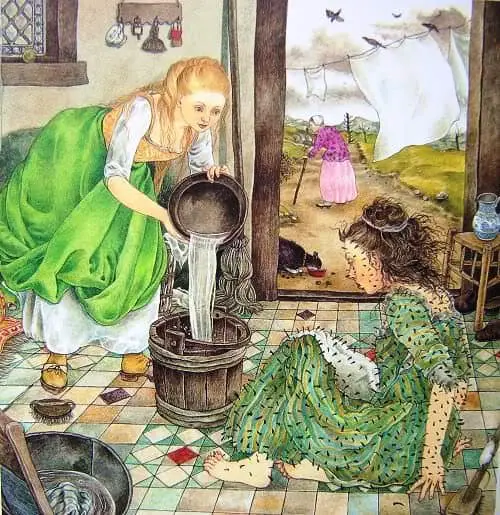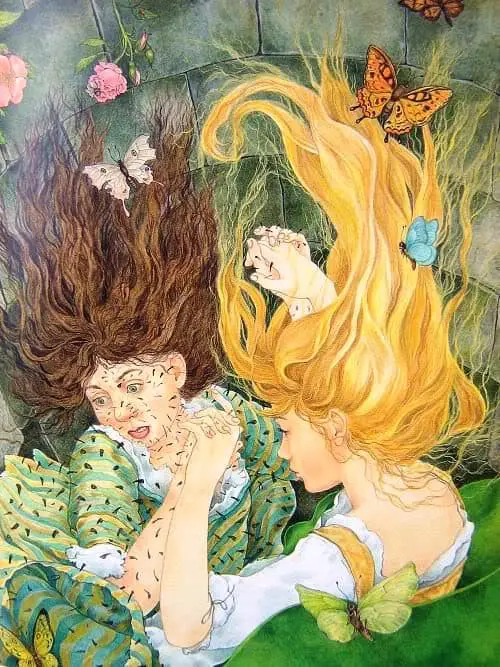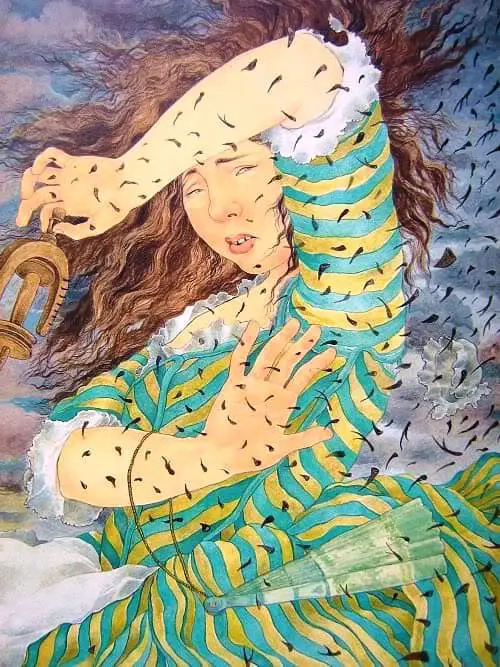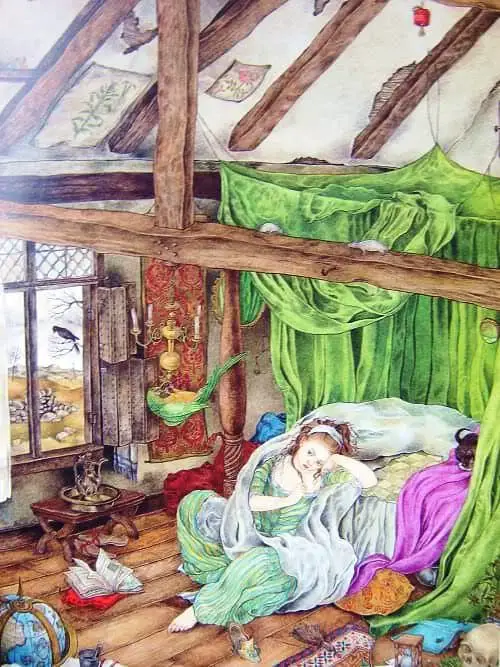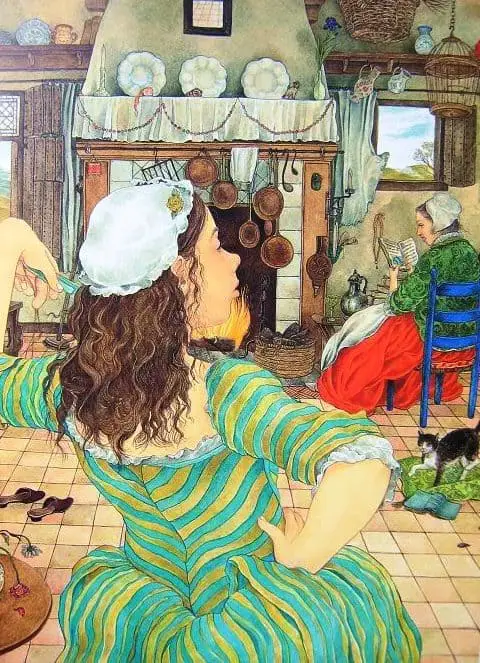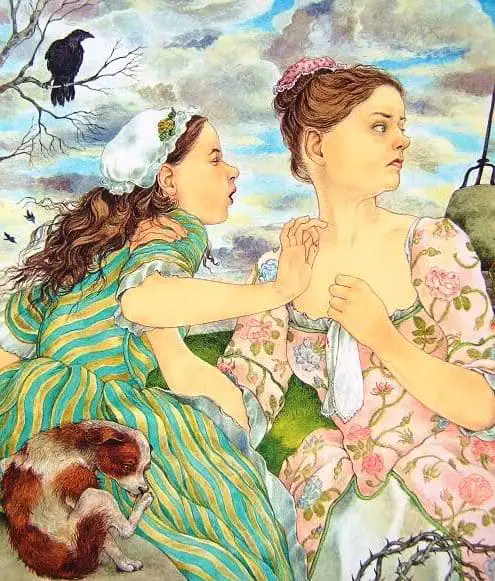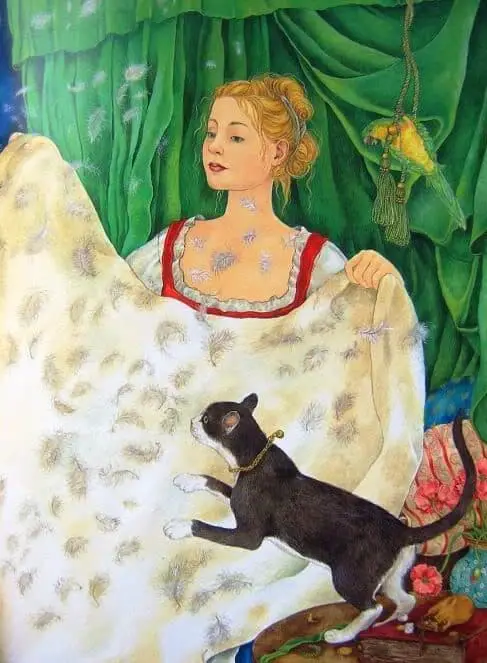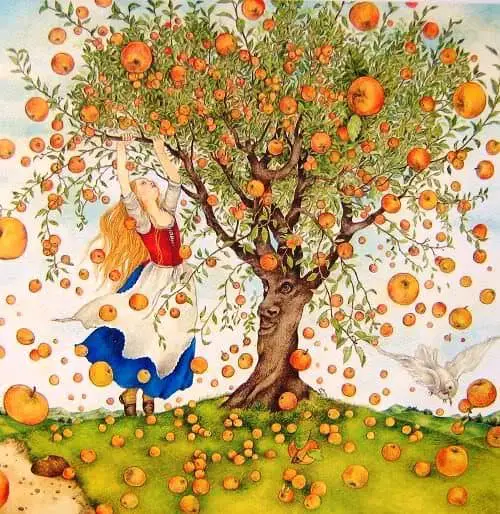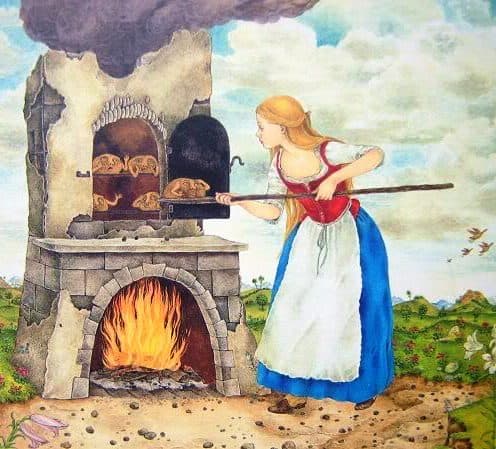“Old Mother Frost” is a German fairy tale also known as “Mother Holle“, “Mother Hulda” and “Frau Holle“. Across cultures, other weather conditions are used: Lady Snowstorm, Old Mother Blizzard in Russia. The Grimm Brothers collected this story for their book Children’s and Household Tales (1812). The narrative seems to comprise jigsaw pieces from Cinderella (for the wicked stepsister and mother), The Frog Princess (for the well/spring) and religious dualistic thinking. It’s clearly a story for and by women and girls. The central image of the spindle suggests it was told among spinsters. This one also has a didactic function: Good girls do housework; bad girls slack off.
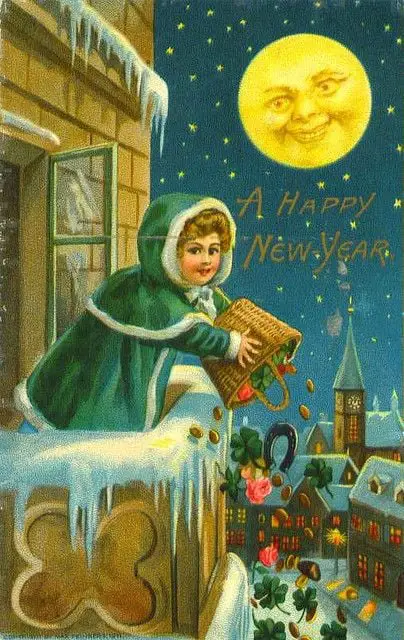
The contemporary reader may read “Old Mother Frost” and think of Neil Gaiman’s Coraline. Both stories are set in the home, which has a portal, and dualistic versions of mother.
The girl main character in “Mother Holle” comes back to the real world in a gold dress. The magnificently sparkly gold dress of James Bond is outta fairyland.
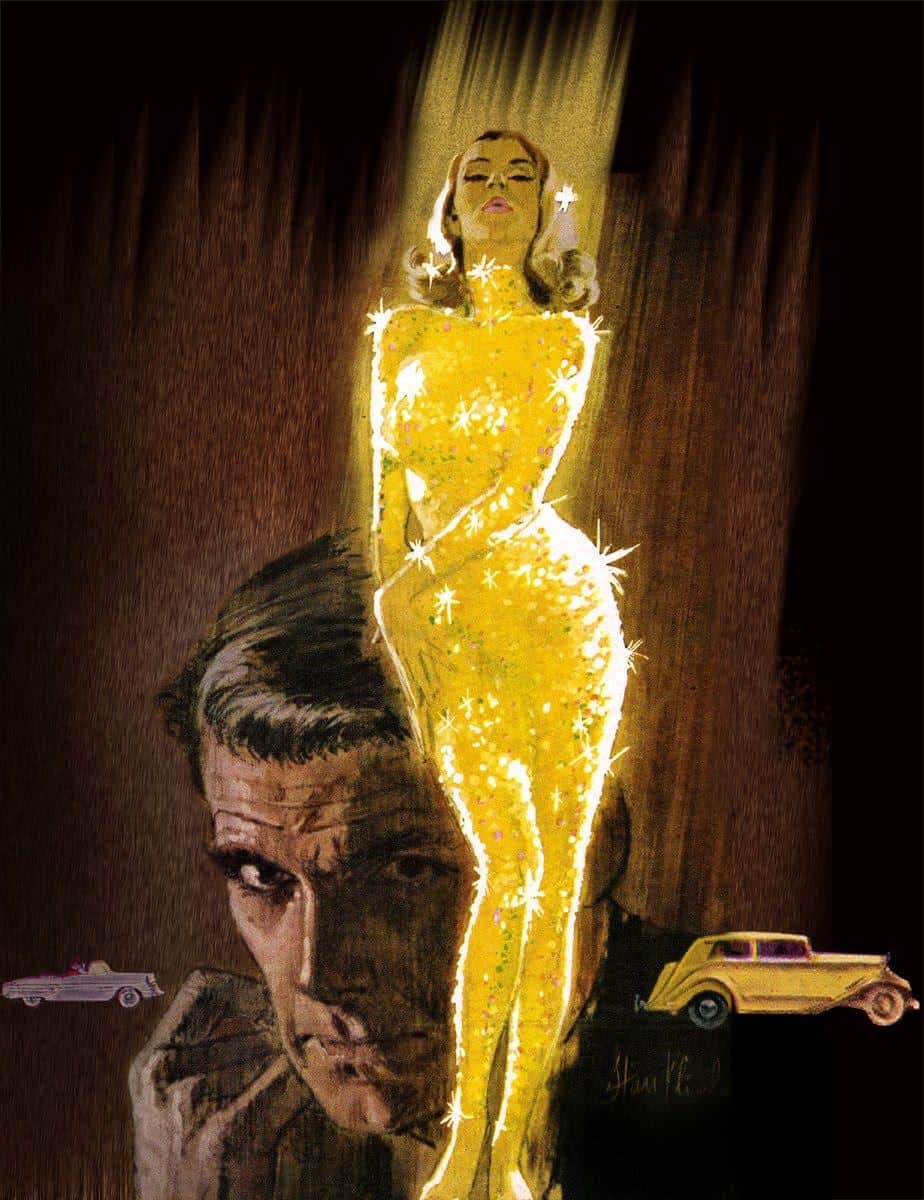
The Grimm fairytales can be found at Project Gutenberg. Old Mother Frost is occasionally included in modern collections but I didn’t come across it until I was an adult. Like many of the Grimm tales, modern storytellers have made it more palatable. The puppet animation directed by Thomas Schneider-Trumpp isn’t too harrowing, I guess. Funnily enough, it contains more of Propp’s fairytale plot points than the version recorded by the Grimms in 1812.
SETTING OF OLD MOTHER FROST
“Old Mother Frost” is set in fairytale land and fairytale logic applies. Weather isn’t mentioned in fairytales unless it’s significant. On top of its function as entertainment and domestic didacticism, this story is a pourquoi tale, explaining why it snows.
The main character is not the titular Old Mother Frost, but a young woman who lives with her stepmother and stepsister. We don’t learn how this little family unit came to be ― I deduce her father married for a second time and then died. Like Cinderella, the pretty step-daughter does all the work around the house while the ugly sister, and genetic descendent of the matriarch, gets to laze around.
Fairytales themselves don’t indulge in thumbnail character sketches. So it’s left to the reader’s imagination when determining exactly what ‘beautiful’ and ‘ugly’ look like. It’s only once fairytales start to be illustrated and animated that storytellers must concretise beautiful versus ugly girls.
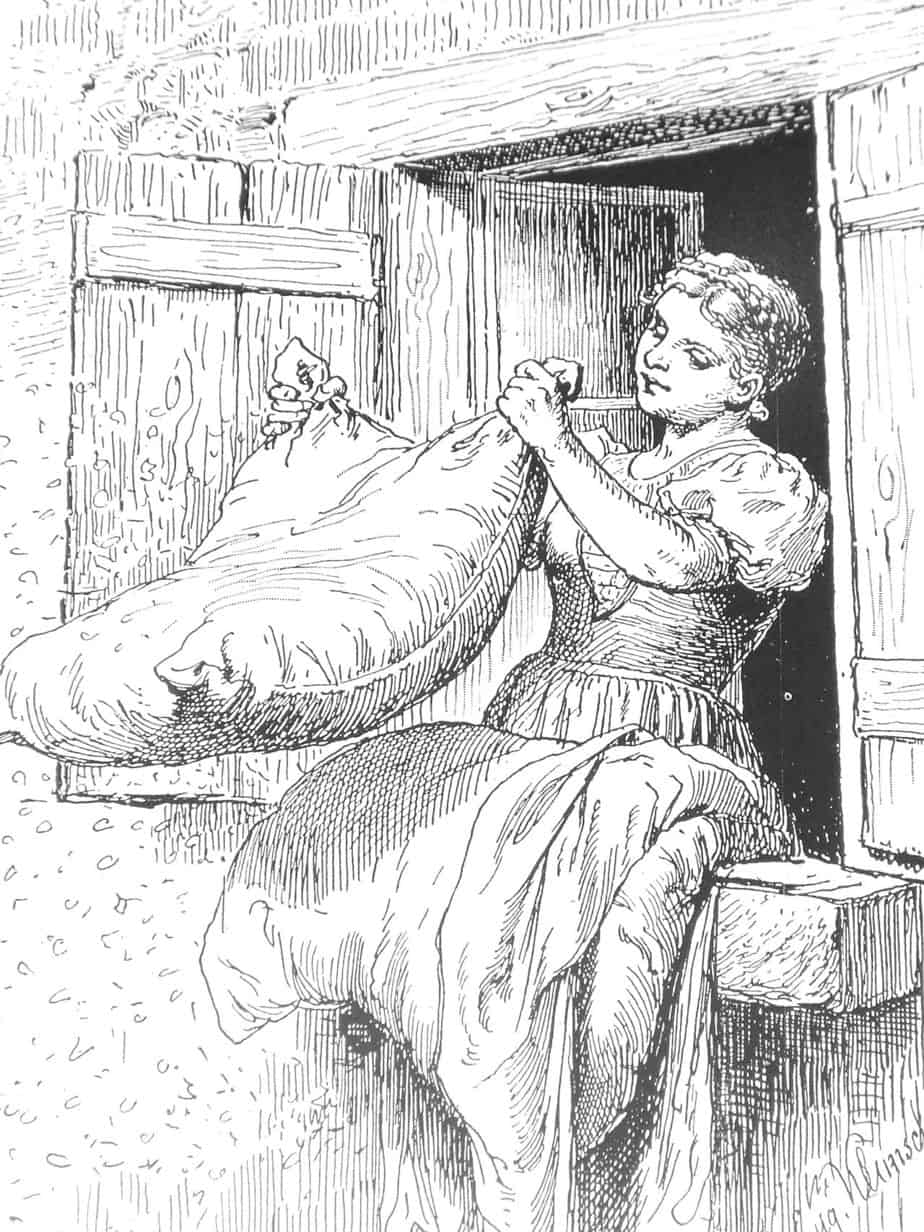
Throughout the 19th and 20th centuries, dribbling on into today, an easy shorthand for ‘beautiful’ is ‘blonde’; the corollary is of course that ‘ugly’ equals dark. This wide-spread imagery has realworld consequences for who gets to be Beautiful and who is Designated Ugly.
Let’s talk about the hair. Why do I call it “yellow’ hair and not “blond’ hair? Because I’m pretty sure everybody calls my hair “brown.” When I read fairy tales to my daughter I always change the word “blond’ to “yellow,’ because I don’t want her to think that blond hair is somehow better.
Tina Fey, Bossypants
In her autobiography, Tina Fey goes on to say how she used to wish she had blonde hair, influenced directly by stories about good blonde girls. (Snow White is a rare exception, but still has the light skin.)
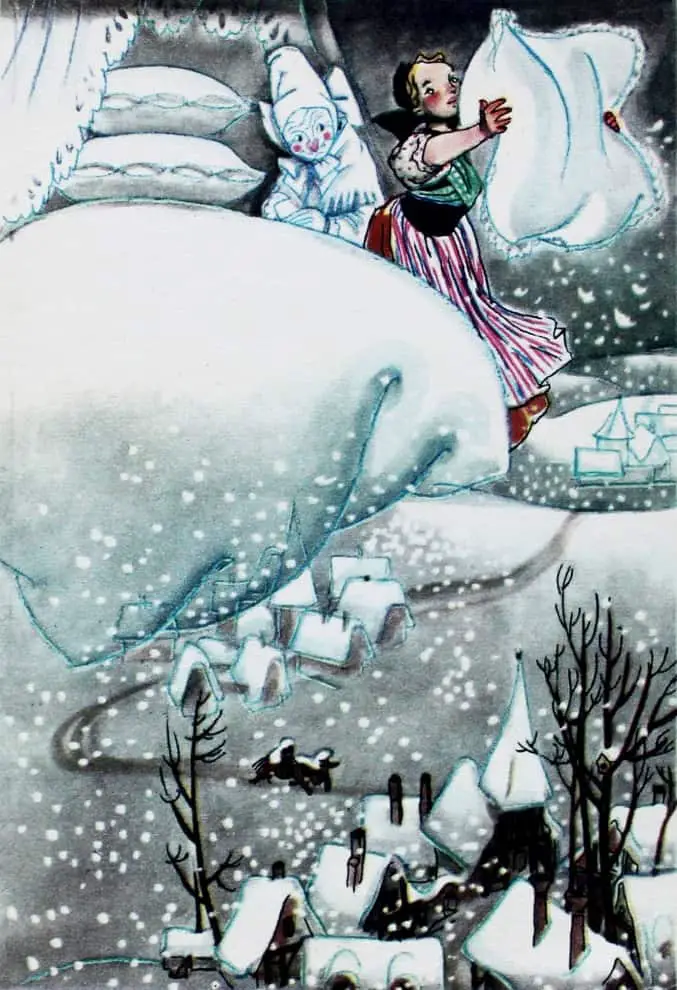
STORY STRUCTURE OF OLD MOTHER FROST
Fairytales pick and choose from a set list of plot points. Find the full version here.
- Absentation: A family member leaves home. In modern children’s literature, you’ve got the home-away-home structure which remains common. In the fairy tales as recorded by Grimm, there’s a fairytale culture in which young men go wandering in the world. But in this domestic story made for and by women, the main character is a girl, so she only goes so far as the well. Her job is to collect water.
- Mediation: Misfortune or lack is made known (to the reader). This is the first stage of storytelling unmasking. The main character is approached with a request or command; they are allowed to go somewhere or they are dispatched. Joseph Campbell would call this the Call To Adventure. The Beautiful Daughter in “Frau Holle” is shown doing all the housework while the stepmother and stepsister laze around being mean and bossy to her.
- Lack: One family member of a family lacks something or desires something. The Beautiful Daughter lacks love at home.
- Interdiction: The main character is given an ‘interdiction’ or warning. Little Red Riding Hood is warned not to talk to strangers. This part of the fairytale contributes to the ideology that as long as we do as we’re told we’ll be fine. This is a conservative, reassuring message (though wrong). Before leaving the house, the Beautiful Daughter is told not to lose the spindle. (So of course we know she’s going to lose the precious spindle.)
- Violation: The interdiction is violated. Little Red Riding Hood speaks to the wolf. The Beautiful Daughter of Frau Holle pricks her finger, gets blood on the spindle, tries to wash it off but drops the entire thing down the well by accident.
- Transference to another kingdom. The well is a portal to another world. In Frau Holle, the girl catches sight of herself in the well. A tear drops into the water which turns the well into a magic portal. She’s drawn inextricably towards it and jumps into the well.
- Donor Tests The Main Character: The main character is tested, and receives a magical helper. Joseph Campbell would call it the mentor. This person is often a fairy godmother, or a talking animal/object who the hero has helped. (The puppet animation gives the Beautiful Daughter a talking animal before she enters the parallel world.) When the girl comes out of the well she’s now in a Heavenly version of her own home, with a nice lady (Frau Holle) to provide comfort rather than the wicked stepmother. Neil Gaiman makes use of this storyline in Coraline, though the realworld mother in that contemporary fairytale is realistically flawed and the nasty mother tricks Coraline by pretending to be perfect.
- Main Character reacts by either passing or failing test. The fairy godmother (Frau Holle) is basically testing the goodness of the Beautiful Daughter by asking her to get on with housework. (In fairytale kingdoms, good girls do housework and they do it well, even if it does not seem fair.) Femininity is highly rewarded in femme presenting characters. This much hasn’t changed, thoug h our definition of inherent femininity has evolved somewhat. But there’s a Save The Cat moment before the housework test, when loaves of bread call out to be saved from the baker’s oven, and Beautiful Daughter comes to their aid.
- Provision of Magical Aid. In Cinderella, a pumpkin is turned into a carriage and horses. In “Frau Holle”, when the Beautiful Daughter thrashes the stuffing out of a pillow and makes it snow on Earth, this is Frau Holle endowing her with a magical power. She can make it snow! She’s in charge of her own realm! The girl can now see her own worth in the world.
- Transference to the original kingdom. Now that she understands her worth, the girl is ready to return to the real world and face her own Minotaur, the wicked stepmother.
- Branding: Main character is marked. In a fairytale, this is a visible marker that the main character has changed. (Or, the mark is made in lieu of real change.) The Beautiful Daughter of Frau Holle may have been beautiful before but now? She is literally golden!
- Return of Main Character.
- Struggle: Main character and villain join in direct combat. The fairytale is divided into two mirrored parts. The Ugly Daughter struggles against both mother figures. Mother Holle quietly watches the Ugly girl be lazy, then sees her punished. In the second part, the sociopathic stepmother switches allegiance from the Ugly Daughter to the Newly Returned Golden Daughter.
- Victory: Main character defeats villain. In this particular fairytale, ‘the universe delivers’. Old Mother Frost gives the good, Beautiful Daughter a golden shower (hmm, that phrase has taken on a newer meaning), but the Ugly Daughter just happens to get a bucket of pitch on her head. (I don’t know about you, but I reckon Old Mother Frost set that up.)
- Initial Misfortune Remedied. In the Grimm version, the Ugly girl is now super ugly forever. In the animation, the stepmother is now required to do the housework.
- Recognition of main character. The Beautiful Daughter is literally golden.
- Exposure of false hero/villain. When the Ugly Daughter doesn’t do as she is told and is not afraid of Frau Holle’s big teeth, this exposes her as unfeminine. Frankly, this bad girl is more in line with your modern ideal of a ‘strong female character’, refusing to be afraid, refusing to spend her day doing pointless housework.
- Transfiguration:Turning golden might go here instead. The reward and transfiguration in this story are conflated. (For a female character, being beautiful is the ultimate reward. It stands her in good stead for a noble marriage.)
- Punishment of villain. The Ugly Daughter is permanently uglier because now she is covered in pitch.
The 21st century animated retelling ends this tale in 21st century fashion. The good sister sticks up for the ‘bad’ sister once her own mother turns against her for failing to return covered in gold. The two sisters become friends. This is now a story about female friendship. There is an historical dearth of stories about female friendship. Historically, female characters are defined by their relationships to men. Many storytellers in the 21st century are working to make up for this.
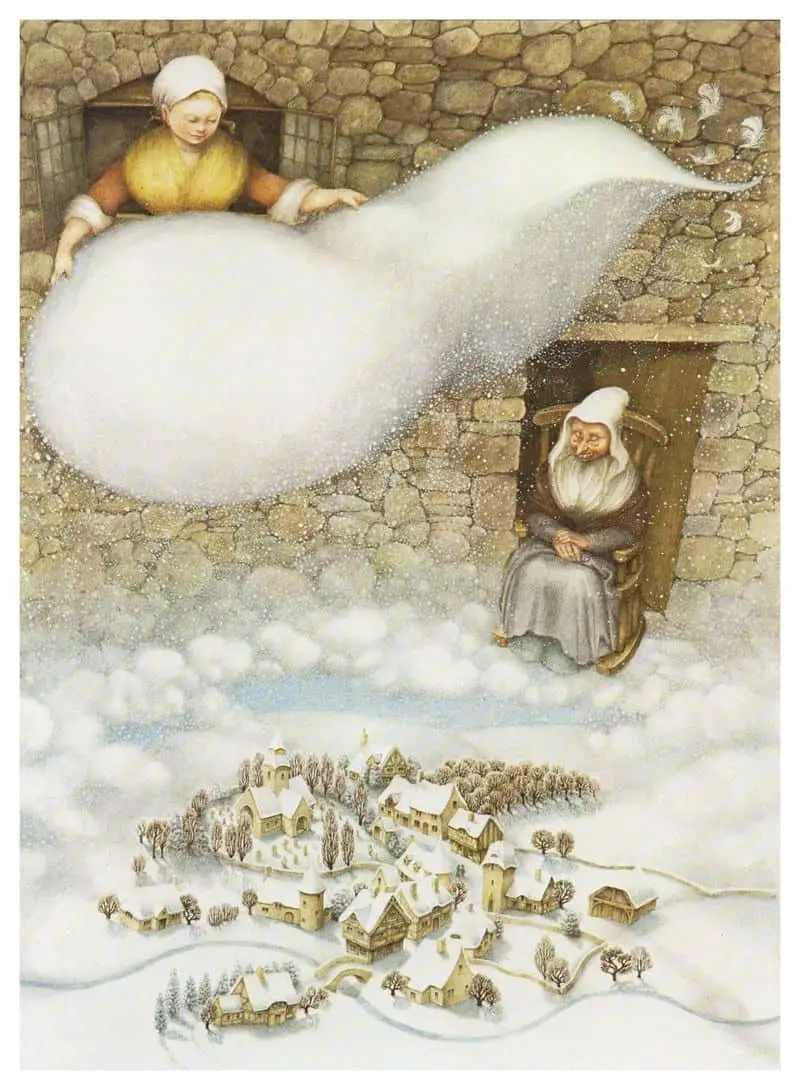
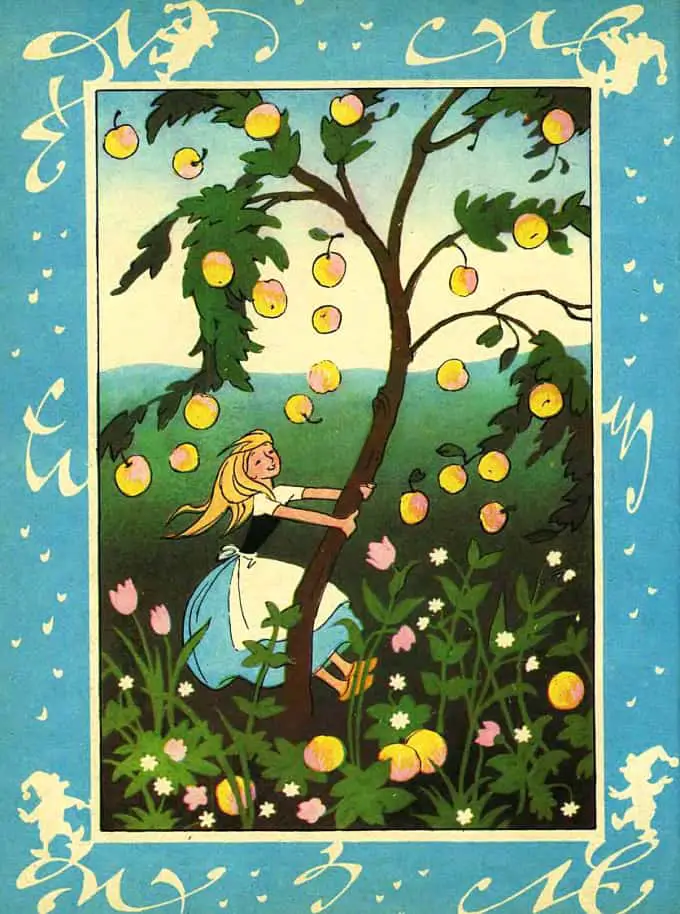
Erik Bulatov and Oleg Vasiliev 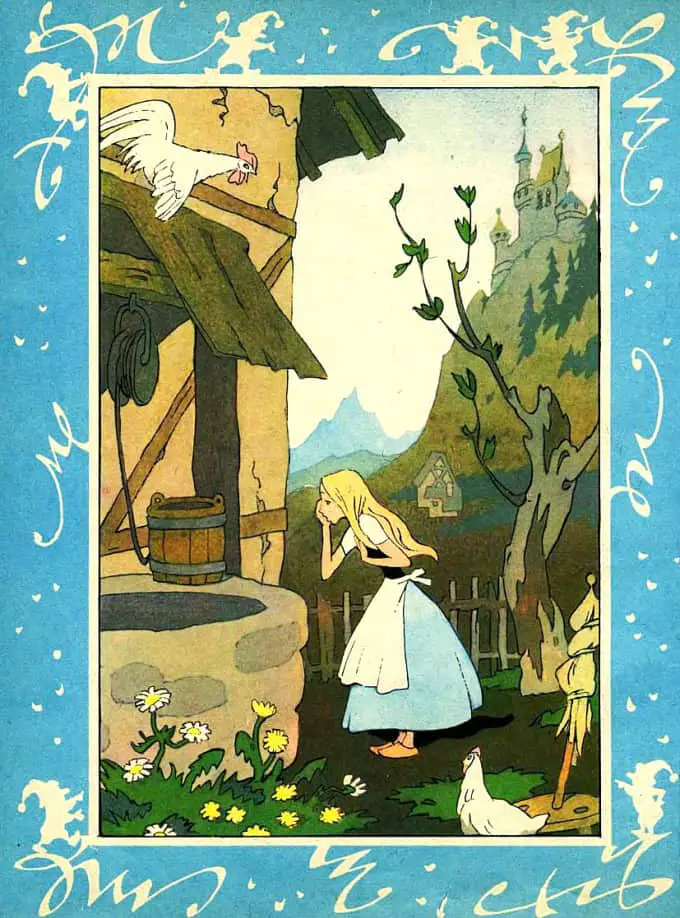
Erik Bulatov and Oleg Vasiliev 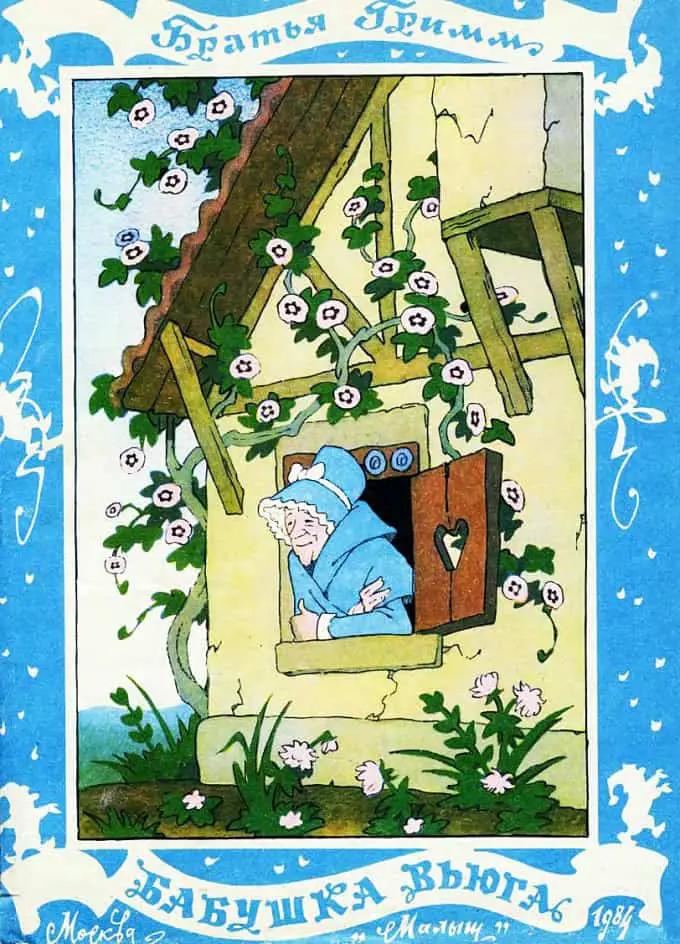
Erik Bulatov and Oleg Vasiliev 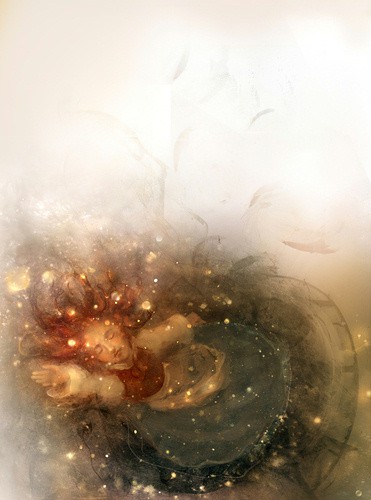
Polina Yakovleva 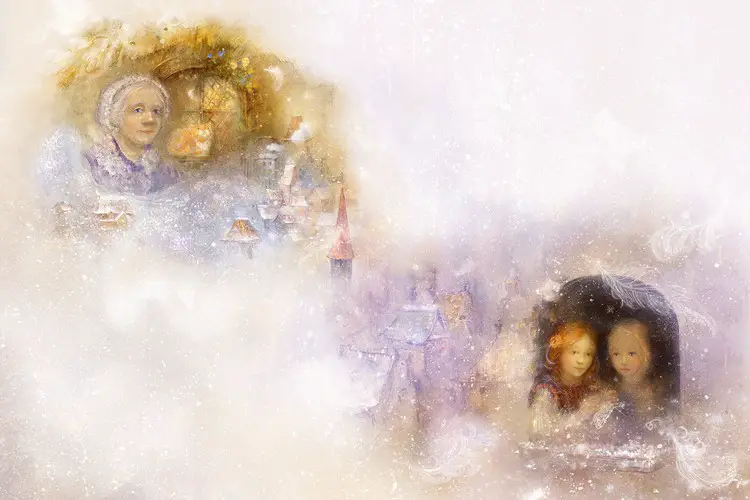
Polina Yakovleva 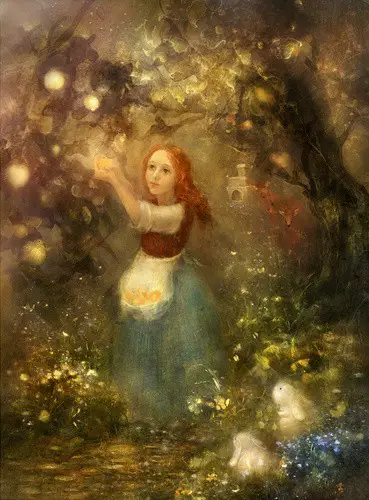
Polina Yakovleva
RESONANCE
What does the research say about genetic offspring versus adopted/step offspring an how they are differentially treated? Looking at statistics such as inheritance, contemporary research says there is no meaningful difference between ‘real’ children and others. We do know that parents treat different children differently, but blood connection is not the decider that fairytales would have us believe.
Header illustration Frau Holle illustrated by Anne Anderson
